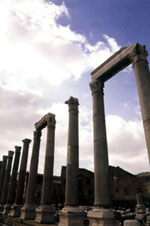Smyrna

Seven Church Ages: Introduction • Ephesus • Smyrna • Pergamos • Thyatira • Sardis • Philadelphia • Laodicea • CAB • Last Messenger?
Smyrna is the second city mentioned in the Book of Revelation to receive a message from Jesus Christ. Smyrna (Greek: Σμύρνη, meaning: myrrh, a perfume) is an ancient city (today İzmir, Turkey) that was founded on the Aegean coast. Aided by its advantageous port conditions, its ease of defense and its good inland connections, Old Smyrna rose to prominence before it was destroyed in the 6th century B.C. Its initial location at the northeastern corner of the tip of the Gulf of Smyrna, commonly called "Old Smyrna", was moved to the southeastern corner of the Gulf of Smyrna on the slopes of Mount Pagos (Kadifekale today) at the time of Alexander the Great. At the heart of the new city is the Izmir Agora Open Air Museum, where ancient ruins still remain today.
Smyrna is roughly forty miles north of Ephesus, and was the birthplace of Irenaeus (a student of Polycarp, who was a disciple of John, who was a disciple of Jesus).
Old Smyrna
Smyrna began as an Aeolian city-state, marking the Aeolian frontier with the Ionian colonies. Smyrna became the thirteenth city-state of Ionia when Ionian defectors hijacked the city while the Aeolians were partaking in a festival to Dionysos outside the city. The Ionians increased Smyrna's defences, but Theognis (about 500 BCE) declared that it was this pride that destroyed Smyrna. Alyattes III of Lydia conquered and sacked old Smyrna in 605 BC, attracted by its wealth, and the Persians thoroughly destroyed the city in 545 BC for supporting Lydia. Though Smyrna did not cease to exist, the Greek life and political unity were destroyed, and the polis was reorganized on the village system.
Old Smyrna's streets ran north-south and east-west, and intersected at right angles. All the houses faced south, and Old Smyrna holds the oldest example of a multi-room dwelling, with two stories, five rooms, and a courtyard. Many of Smyrna's streets were paved, and Old Smyrna contained a Temple of Athena from the 7th century BC.
Hellenistic Smyrna
Alexander the Great refounded Smyrna around 300 BC, and its consruction was carried out by his successors who enlarged and fortified the city. As Old Smyrna could only handle a few thousand people, the Hellenistic city was moved on the modern site of Izmir. The beauty of the Hellenistic city, clustering on the low ground and rising tier over tier on the hillside, was frequently praised by the ancients and is celebrated on its coins. Hellenistic Smyrna had an acropolis, stadium, theatre, a temple to Zeus ("Father of the gods"), and a temple to Cybele (the "Great Mother").
At the end of the Hellenistic period, in 197 BC, the city suddenly cut her ties with King Eumenes of Pergamum and instead appealed to Rome for help. In 195 BC, the city of Smyrna started to deify the city of Rome, and became the inventors of the cult of the goddess Roma. This marked the end of the Hellenistic period.
Roman and Byzantine Smyrna
Smyrna grew substantially under Roman rule, vying with Ephesus and Pergamum for the title First City of Asia with a population of about 200,000. A Christian church existed here from a very early time as there was a considerable Jewish population in the city. Polycarp, bishop of Smyrna, was martyred in the city in 153 AD. In 178 AD, a severe earthquake leveled the city, and the Roman Emperor Marcus Aurelius contributed to the rebuilding of Smyrna as the damage was too great for the residents of Smyrna to handle on their own.
When Constantinople became the seat of government, the trade between Anatolia and the west lost in importance, and Smyrna declined. The city was exchange hands between the Turks and the Crusaders several times after 1000 AD, and today it is a liberal Muslim city in Turkey. The major conquests were as follows:
- Seljuks, Çaka Bey in 1076 AD,
- Crusaders, Knights of Rhodes in 1204 AD,
- Turks & Genoese around 1344 AD (cohabbiting Muslims and Christians)
- Ottomans, Bayezid I in 1389 AD
- Mongol, Tamerlane in 1402 AD
- Ottomans, Murad II in 1425 AD (assisted by the Knights Templar in return for a castle)
References
- Wycliffe Dictionary of Biblical Archeology, Charles F. Pfeiffer. 1973, Baker Book House Co.
- This information is based on material from Wikipedia. As a result, this article is licensed under the GNU Free Documentation License which governs this website as well.
Footnotes